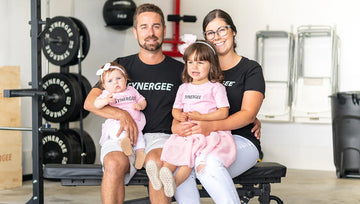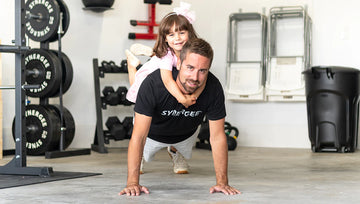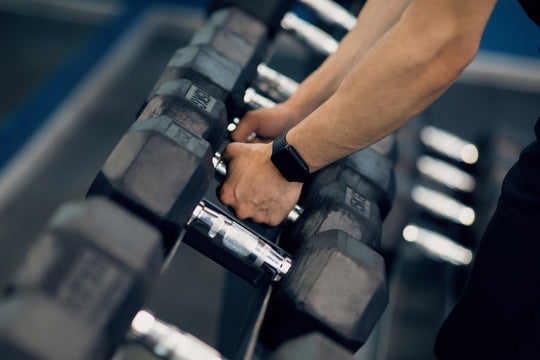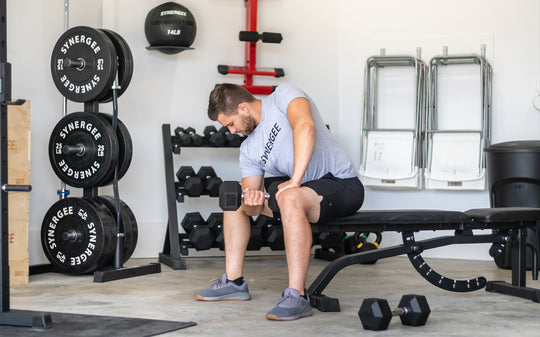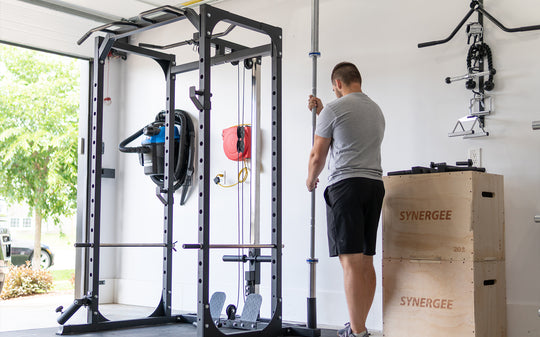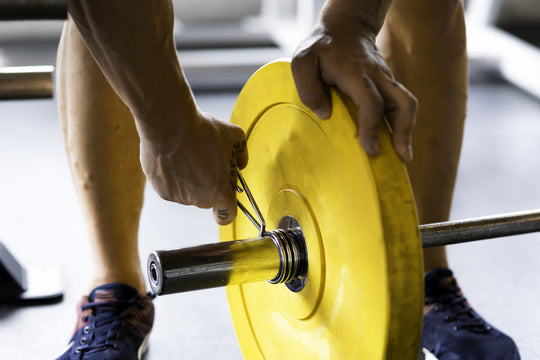Squat Rack v.s. Power Rack: Full Comparison
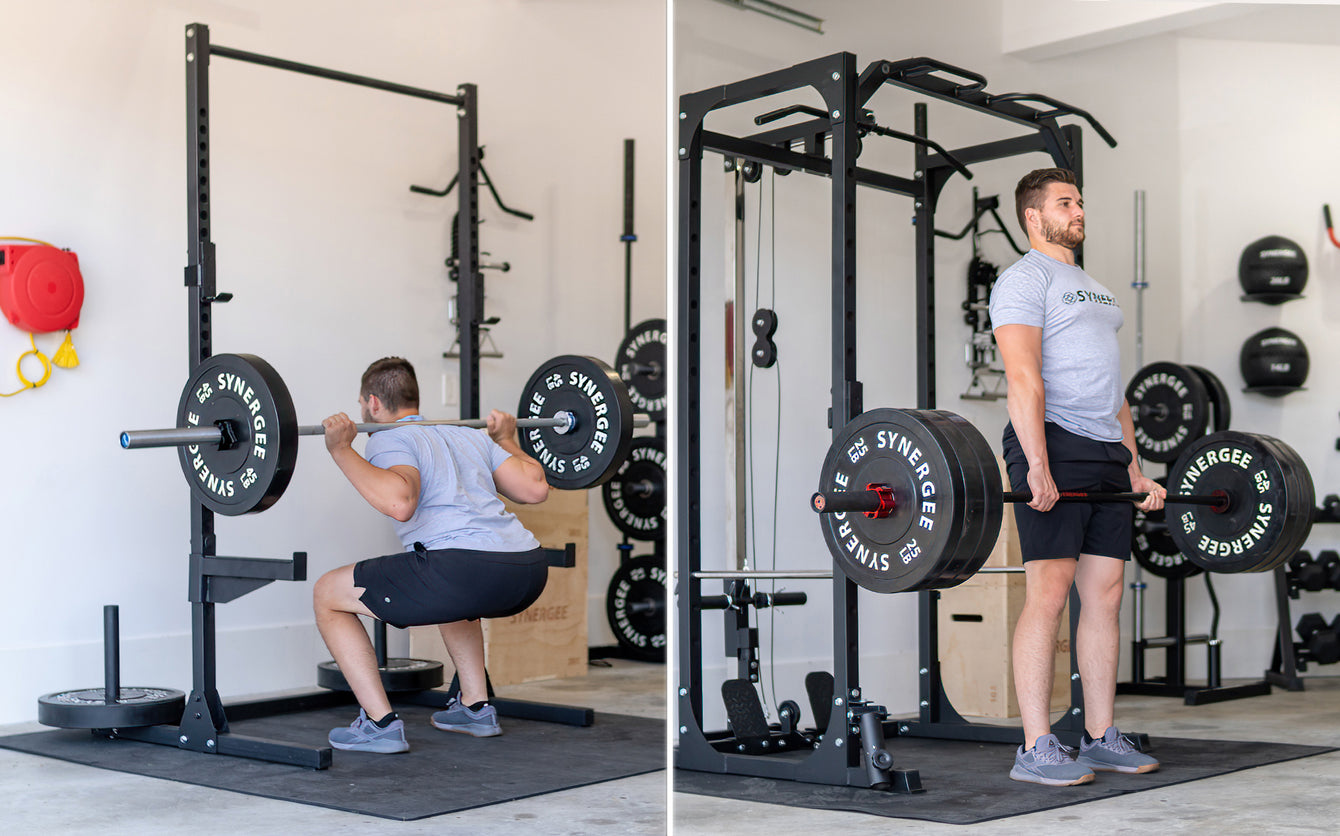
If you’re putting together a home gym, and you like lifting heavy, you might be trying to decide which kind of squat rack to buy. You probably use a power rack at the gym, but maybe a regular squat rack seems like a good idea once you check the prices.
So which is best for a home gym? Well, it depends. While we can generally say that the power rack is safer and more versatile, it may not be best for everyone in all situations. In this article, we’ll break down the differences between a squat rack and a power rack. We’ll also offer some insight into which type of rack might be best for your home gym.
First, a Little History…
Once upon a time, getting a barbell on your back wasn’t easy. If you wanted to front squat, you could clean the bar into a front rack position. But if you wanted to back squat, you had to tilt the barbell and climb underneath it, which was both dangerous and inefficient. Times were tough.
In the early 20th century, the squat rack was popularized as a solution. But while barbell setup and training became easier and safer, squat racks still lacked key features that would allow lifters to train to their limits.
By the 1960s, some enterprising exercise experts developed a modified squat rack that would come to be known as a power rack. This new cage-style design provided unique safety features that allowed lifters to bail out of lifts safely without being crushed by the barbell.
Squat Rack Terminology
The term “squat rack” can be used to describe any kind of rack that holds a barbell. It’s how you might use the term “cars” to describe all motor vehicles, but then use the same word “car” to differentiate between cars, trucks, vans, etc.
In the same way, the term “squat rack” can be used to describe all barbell-holding racks. But it can also be used to differentiate a regular squat rack from specialty equipment like a power rack. In other words, there are many types of squat racks, and a power rack is one of them. We bring this up because you might hear the terms used interchangeably when researching different products.
However, there are notable differences in the general design of each rack:

What Is a Squat Rack?
A traditional squat rack is a piece of equipment designed to hold a loaded barbell at various heights. Squat racks are characterized by two vertical uprights usually connected by a baseplate and/or pullup bar, with moveable j-hooks to hold the barbell.

What Is a Power Rack?
A power rack is an enhanced version of the squat rack, characterized by four uprights that create a cage-like design. The enhanced strength and stability of the cage give the lifter the option of safely dropping a failed lift on pins or straps designed for this purpose.
Squat Rack v.s. Power Rack
Comparing a squat rack to a power rack is not like comparing a car to a boat. It’s more like comparing a car and a pickup truck. Both basically do the same thing, but the truck is bigger, generally more expensive, and more capable for certain exercises.
The question is: do you need the extra capabilities of the “truck,” or will the “car” be fine for what you want to do? Here are some key characteristics that differ between the two designs.
- Size - A power rack can be twice as large as a squat rack, taking up additional floor space in your home gym. Squat racks vary widely in size and design, so it’s tough to say all power racks are bigger than all squat racks. But in most cases, power racks are bigger and heavier.
- Stability - A power rack is generally more stable than a squat rack due to its cage-like design. This is critical for safety after a failed lift and for performing dynamic movements like pull-ups. Too much horizontal force on a squat rack will cause the system to wobble or even tip over.
- Safety - The power rack was developed specifically to make up for the safety shortfalls of the traditional squat rack. To reach their potential, lifters needed to train with near-maximal loads, which always presents the danger that the lifter will be unable to re-rack the bar. In these cases, the lifter needs a way to “bail out” safely without damaging themselves or their equipment. The cage design allows for the inclusion of safety straps and/or pins, so you can drop the bar without it going through the floor. It also prevents you form crushing yourself under a bench press or getting stuck in the bottom position of a squat. Remember, the system is designed to protect the lifter experiencing maximum fatigue. This is especially important for home gyms where lifters might be training alone. The last thing you want is to get caught under a bench press with no way out.
- Versatility - The power rack’s safety features also help improve the versatility of the system. For example, the safety pins can be height-adjusted to allow for rack pulls, half presses, and other partial exercises to train specific ranges of motion safely and effectively. The enhanced stability improves the effectiveness of movements like pull-ups, but also makes it possible to add attachments such as a dip stand which might destabilize a standard squat rack.
- Cost - The additional size and features of a power rack naturally increase the price — it’s essentially two squat racks welded together. But interestingly, while power racks have twice the steel of squat racks, they usually cost less than twice the price of a standard squat rack.
- Variety - Squat racks tend to be more varied in design, as each design tries to solve more problems or support certain modes of training. Power racks tend to have the same general form but vary in size and accessory availability.
- Mobility - Due to its smaller size, a squat rack is more mobile than a power rack. It’s possible to move it between workouts in case you need the space for other activities. The size and weight of a power rack mean that it’s usually not going anywhere once it’s in position.
Comparison Summary
Here is a chart summary illustrating the differences between the two racks.
Squat Rack vs. Power Rack: Side-by-Side
| Characteristic | Squat Rack | Power Rack |
| Uprights | 2 | 4 |
| Moveable j-hooks | Yes | Yes |
| Pull-up bar | Yes | Yes |
| Spotter arms | Sometimes | Yes |
| Safety pins | No | Yes |
| Safety straps | No | Yes |
| Dip attachment | No | Yes |
| Size | Less | More |
| Stability | Less | More |
| Safety | Less | More |
| Versatility | Less | More |
| Cost | Less | More |
| Variety | More | Less |
| Mobility | More | Less |
Which Rack Is Best for a Home Gym?
In general, the power rack is the superior piece of gear. Power racks are more versatile, stable, and safe — critical factors for training at home. If you have the space and the money, the power rack is the ideal choice.
However, there may be some limiting factors preventing you from getting a power rack. Back to our car/truck analogy, even if we know a truck is ideal, that doesn’t mean we can always get one. Maybe we don’t have anywhere to park it. Maybe we can’t afford it. Or maybe we just hate trucks and have no interest in the extra features that come with it.
Deciding between a power rack and a regular squat rack presents a similar dilemma. Most lifters agree that the power rack is the superior choice. But there are a few factors that might cause a lifter to choose a squat rack instead: space, cost, and preference.
Space
This is the most common limiting factor when shopping for a squat rack for a home gym. The bottom line is, squat racks and power racks are just big. If you don’t have the space to use a piece of equipment like this, that’s the end of the story. Compared to the normal stuff we put in our houses (such as couches, refrigerators, tables), squat racks (even small racks) are pretty big pieces of equipment.
Plus, you need additional space to actually train. You need space on either side of the bar for loading plates, and you need space in front of the rack to do other exercises. Any of these can be a limitation that prevents a power rack from fitting in your home gym.
And you don’t want to cram it in, either. Just because a power rack can technically squeeze into a room doesn’t mean that it should. In those cases, you’re better off with a squat rack. But you also might find that some racks fit better than you expect. For example, our Synergee Power Rack is specifically designed to fit in small spaces.
And if that doesn’t work, you can always check out folding racks. They offer most of the stability benefits of a power rack but can fold flush against a wall. This is particularly useful if your home gym is multi-use and you need to make room for other functions and activities.
So while the power rack is probably best for your home gym, any squat rack is better than none. Measure your space and find the one that fits.
Cost
The next most limiting factor for a home gym is cost. Even though you may see the value in owning a power rack, some price tags might be too high for your budget. But it’s important to put the price in context. Whichever rack you buy might last the rest of your life.
Squat racks (and barbell equipment in general) are fairly unique compared to the other products we buy. How many purchases do we intend to keep forever? Clothes, furniture, and cars, while all expensive investments, aren’t usually bought with the intention of keeping them forever. But the squat rack is not an item that will go out of style. A quality squat rack can be used almost forever, so it’s important to consider the price over that timeframe. Trying to save 100 dollars by buying a lesser piece of gear may not be worth it over the long term. It’s far more important to find the exact rack that suits your needs.
You also need to consider your long-term training potential. You may not care about maxing out your squat or doing rack pulls now. But if there is a chance you might in the future, it makes sense to get the power rack that will accommodate those efforts.
Finally, remember that the stakes of weight training are high. If you’re worried that your gear will break, how can you train with confidence? This isn’t like buying the no-brand Fruit Loops at the grocery store. This is one of those times when it really makes sense to buy quality gear from a trusted name.
Preference
The least critical limitation is preference. Maybe you just don’t like power racks or have no use for the additional features. This might be like buying a pickup truck when you live downtown — it’s likely more of a burden than a benefit.
However, in almost all cases, you’re better off buying a power rack if you have the space and can afford it. The benefits for training solo at home with a power rack cannot be overstated. So, choose carefully.
Pick Your Ideal Rack from Synergee
Here are a few recommendations we think are ideal for weight training at home. Of course, our top choice is our power rack. But if it won’t fit your home gym or you don’t want to spend the extra money, our squat rack will get the job done, too. Here are some details:
Synergee Squat Racks
| Standard Squat Rack | Synergee Power Rack |
 |
 |
|
We offer a quality squat rack perfect for home gyms. If you don’t have the space for a power rack or you just don’t want one, this squat rack is a great solution. The rack is 84” tall, the uprights are 2x2” 12-gauge steel, and the system can hold up to 750 lbs – more than enough even for world-class lifters. The set includes a pullup bar, 2x j-hooks, 2x spotter arms, a landmine attachment, and 2x plate posts for storage and stability. |
This rack does a lot more than just hold a barbell. Our power rack provides maximum safety and versatility for your home gym. This rack is 81” tall, so it can fit almost anywhere. Like the squat rack, the power rack uprights are 2x2” 12-gauge steel and can hold 750 lbs. In addition to everything included with the squat rack, you also get a barbell holder, a dip stand, a T Bar attachment, 2x safety pins, and a footboard. It’s almost an entire gym in a single package — and it can fit almost anywhere. It offers maximum versatility and safety in a compact package perfect for most home gyms. |
Conclusion
Squat racks and power racks both do essentially the same thing: hold a barbell. The power rack is safer and more stable, but generally at a higher cost and with a bigger footprint. We recommend selecting the power rack if you have the space and the money.
But whether you’re in the market for a squat rack or power rack, Synergee offers everything you need. We specialize in home gym equipment designed for you and your family. We believe that everyone should have access to high quality home gym equipment without compromising their budget or family activity space.
This philosophy filters down into the design of everything we make — including our low-profile power rack specifically designed to fit in small spaces. Plus, any power rack or squat rack you buy from us automatically qualifies for free shipping, along with any other order you place for $50 or more.
Our equipment also includes an industry-leading, no-sweat guarantee. If you need to return or replace any of our products, we take care of it at no extra cost to you.
Ready to start training hard? Check out our collection of racks today.

